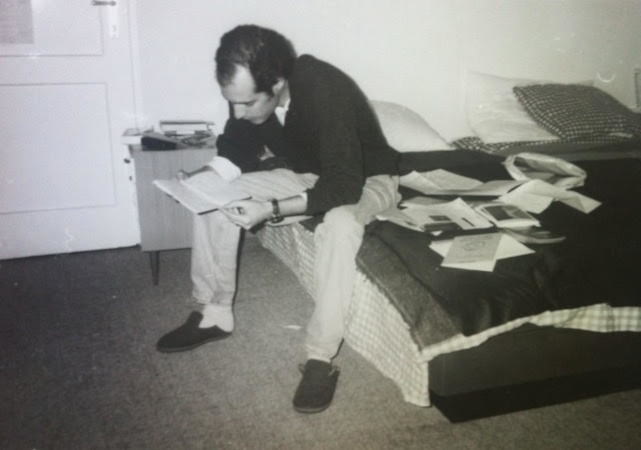ABOUT
CURRICULAR SUMMARY
Roberto Rébora
(March 11, 1963; Guadalajara, Jalisco, Mexico)
With a career that spans more than thirty years, he has been recognized for the vigorous of his strokes, and for his economy of means based on technical knowledge and refinement of the pictorial matter. His most recent pictorial series are Media Star (2013-2018), Flujo Mundo (World Flux; 2018 to date), Tipografías (Typographies; 2020), and Suite Tours (France; 2021).
His work is part of collections both private and public. Among the Mexican institutions that own pieces of his are the Museo Rufino Tamayo de Arte Contemporáneo (Mexico City), the Museo de Arte Carrillo Gil (Mexico City), the Museo de Arte Contemporáneo de Monterrey (Monterrey), El Colegio Nacional (Mexico City), the Museo de las Artes of the Universidad de Guadalajara (Guadalajara), Museo de Arte Contemporáneo de Oaxaca (Oaxaca), Museo Amparo (Puebla), Museo Arocena (Torreón), and Museo Claudio Jiménez Vizcarra (Guadalajara). Likewise, the Mexican institutional collections Pago en Especie of the Secretaría de Hacienda y Crédito Público, BBVA-Bancomer of the Fundación Cultural Bancomer, and Siglo XXI of the Secretaría de Relaciones Exteriores.
Rébora has published booklets and monographs, among them Si existieras, señor Mecenas (If You Existed, Mister Patron; Mexico, Cuarto Menguante, 1982), Inmaterial (Immaterial; Mexico, Taller Ditoria, 2011), and Materia y discurso de fe / Matter and Discourse of Faith (Mexico, Turner-Páramo, 2016).
In 1995 he founded Taller Ditoria, which publishes literary works in typographic and manufactured editions.
Currently is a beneficiary of the 2019-2022 emission of the Fondo Nacional para la Cultura y las Artes of the Sistema Nacional de Creadores de Arte in his country (Fonca-SNCA). Since 2021, divides his time between Tours (France), Guadalajara (Jalisco), and Mexico City.
Two satisfying experiences
XVth Rufino Tamayo Painting Biennial 2011
Unveiling of the painting Teodoro González de León as part of the Collection of Portraits of Members of El Colegio Nacional (Mexico)
Expressly requested by the architect himself to the artist, completed in 2004 and acquired by El Colegio Nacional in 2005, the portrait of Teodoro González de León (1926-2016) could only be exhibited to the public posthumously.
The unveiling of work was on December 12, 2018, during the tribute made to whom was a member of El Colegio Nacional since 1989.
The portrait painted by Rébora is already hanging in its corresponding place at the portrait gallery.
MATERIALS - TECHNIQUES
The medium that generates the plasticity in the pictorial image has its origin in the use of mineral and vegetable pigments—colours—mixed with natural binding substances: animal fat, resins and their varnishes, egg, linseed oil. Alchemy. The corpus of painting rests on that knowledge, reason why we are able to preserve and to admire the art through time, through its history.
The industrial technological modernity largely displaced the knowledge of traditional techniques towards the outside in its few continuators. Practically all 20th century painting is made with industrial materials—with exceptions such as De Chirico, among the best-known artists. Industrial materials facilitate the technical procedure, making it of an extremely simple practicality. Is not that the way with which I feel affinity.
For me, in respect of my current work, the important thing about the technique is to apply it to describe the electric light of our present.
VLADY: THE MASTER, THE FRIEND
While Rébora living in Florence—where he studied Tuscan mural painting, unhurriedly—, in one of his temporary visits to Mexico attends the exhibition Confrontación (Confrontation) at the Palacio de Bellas Artes, and he meets Vlady Kibalchich Rusakov.
My meeting with the master’s work and his person, around my twenty-six, twenty-seven years, conditioned my aesthetics and my expression. Thanks to him, I understood that the importance of technique lies in adapting it to the contemporary spirit taking benefit of its plastic value.
At one point in his career, initially being a modern-industrial painter but, due to his cultural training, always an admirer of classical painting, fundamentally of the European figurative tradition—Raffaello, Tiziano, Tintoretto, all of the canon—, Vlady backs down, aware of his own technical insufficiency, and he undertakes the study and the practice of the millenary techniques until mastered the medium and the craft, a command evident in his later work, both easel and monumental painting. Thereby, in the mid-20th century, Vlady—already immigrated in Mexico—opposed the reduction of the craft of highest school born of painting ancient caused by the massive use of industrial products, which not only simplified but also replaced the intimate knowledge of materials and the procedures that have given permanence and unique values to pictorial expression over time.
Vlady devoted his efforts to the research and study of the applications of thick linseed oil, as well as of other substances mixed with natural pigments, to achieve the infinite sensible possibilities of the matter and its coherent and methodical use.
To know more:
Centro Vlady | Vlady Center (Mexico City)
21 de julio 2005 / Muerte de Vladímir Kibálchich Rusakov | July 21, 2005 / Death of Vladimir Kibalchich Rusakov
































